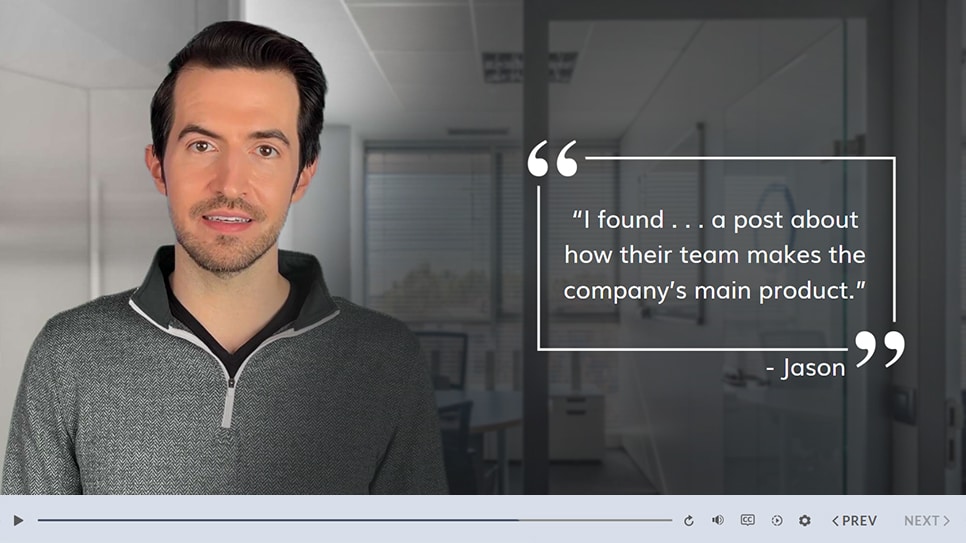
Protecting Intellectual Property Training
Protect your intellectual property by ensuring your valuable assets stay secure and in the right hands.
Course description
Traliant’s Protecting Intellectual Property training is a 20-minute course that helps learners understand how to identify intellectual property (IP), determine its ownership, gain insight into the legal protections available for IP, and recognize their responsibilities in safeguarding IP and respecting the rights of its owner. It also covers the primary IP rights protected under US law, including trademarks, copyrights, patents and trade secrets.
ONLINE TRAINING
Protecting Intellectual Property Training

The course covers these topics and more:
- Understanding the four main types of IP
- Trademark
- Copyright
- Patent
- Trade Secret
- How to identify who owns IP
- How to safeguard IP owned by an organization
- How to uphold the rights of an IP owner and the laws protecting them
- How to request permission to use IP owned by another
THE TRALIANT DIFFERENCE
Compliance you can trust.
Training you will love.

Legal expertise
Our in-house legal team monitors the latest laws, rules and regulations, so you don't have to. You can rest assured that our courses are continuously compliant.

Brilliant training
Take your training from boring to brilliant. With cinematic-quality videos produced by our Hollywood-based team, your employees will love our customizable, interactive, story-based training.

Valued partnership
Our main focus? It’s all about making your job easier. We do that with unmatched responsiveness and seamless deployment, dedicated to driving your success.

Meaningful impact
We don’t just deliver brilliant training, we help you create meaningful impact by broadening your employees' perspectives, achieving compliance and elevating culture.
KEY FEATURES
Why you'll love our training
It’s time to embrace a new era of online training with a valued partner who will ensure seamless implementation, a truly enjoyable learning experience, and courses with continuous compliance you can trust.
Compliance expertise
Traliant's in-house legal expertise ensures training is accurate and kept up-to-date with any regulatory changes.
Accessible to users with disabilities
Traliant provides an inclusive experience for all users, including those with disabilities, by going beyond Section 508-C standards and offering WCAG 2.1/2.2 AA.
Story-based learning
Our story-based approach blends leading instructional design with Hollywood talent to produce engaging, interactive and nuanced training.
Course administration
Traliant makes it simple to roll out training to your workplace and provide technical support directly to your employees at no additional cost.
Course customizations
Tailor courses to include your logo, relevant policies, workplace images, and more. Traliant can even customize the course with scenarios that take place in your own workplace environment.
Translations
Training is available in English, Spanish and is supported in over 100 languages.
COMPLIANCE EXPERTISE
Your partner in training compliance

Uniquely qualified in-house compliance team
Our exceptional in-house Compliance Advisory Team is led by Michael Johnson, Chief Strategy Officer and former U.S. Department of Justice attorney who has provided training and guidance to organizations like the Equal Employment Opportunity Commission, Google, the United Nations, and the World Bank.

Keeping you compliant, effortlessly
Keeping up with the complex web of employment laws — especially if your workforce spans multiple states — can be tricky. That’s why we offer a streamlined training solution that ensures you stay compliant with federal, state, and local regulations, so you can focus on what matters most: your team.

Simplifying your policies and handbooks
Crafting an employee handbook that meets legal standards can be daunting. Let us ease the burden. We help you navigate regulatory changes to ensure your policies and handbooks not only comply with the law but also reflect industry best practices.
What to consider when choosing the most effective protecting intellectual property training

- Promote a culture of innovation and responsibility: Training helps to create a culture where employees understand the value of IP and are committed to protecting it.
- Minimize legal and financial risks: IP infringement can lead to costly lawsuits and damage to the organization's reputation. Training helps to mitigate these risks.
- Safeguard the company's competitive advantage: IP is a valuable asset for many organizations. Training helps to ensure that employees understand how to protect the company's IP and to avoid inadvertently disclosing confidential information.
- Empower employees: Training provides employees with the knowledge and skills they need to understand IP and to handle it responsibly.
- Strengthen your organization's IP protection strategy: Training helps to build a strong IP culture, making it more difficult for competitors to steal or misuse the company's intellectual property.
- Reduce the risk of IP infringement: Training helps employees to understand the legal consequences of IP infringement and to avoid engaging in activities that could put the company at risk.
- Patents: Exclusive rights granted for inventions, allowing patent holders to exclude others from making, using, selling, or importing the invention for a limited period.
- Trademarks: Distinctive signs, such as words, logos, symbols, or designs, that identify and distinguish goods or services of one party from those of others.
- Copyrights: Legal rights granted to the creators of original works of authorship, such as literary, dramatic, musical, and certain other intellectual works.
- Trade Secrets: Confidential information that provides a business with a competitive advantage, such as formulas, practices, designs, instruments, or a compilation of information.
- Patent infringement: Making, using, selling, or importing a patented invention without the patent holder's permission.
- Trademark infringement: Using a trademark that is confusingly similar to a registered trademark, without the trademark owner's permission.
- Copyright infringement: Copying, distributing, or performing a copyrighted work without the copyright owner's permission.
- Misappropriation of trade secrets: Acquiring or disclosing a trade secret without the owner's consent.
- Be aware of company policies: Understand the company's IP policies and procedures.
- Keep confidential information secure: Take steps to protect confidential information, such as using strong passwords and limiting access to sensitive documents.
- Avoid sharing IP with unauthorized individuals: Do not share company IP with competitors, clients, or other individuals who are not authorized to access it.
- Report suspected infringement: If you believe that someone is infringing on the company's IP, report it to the appropriate authority.





